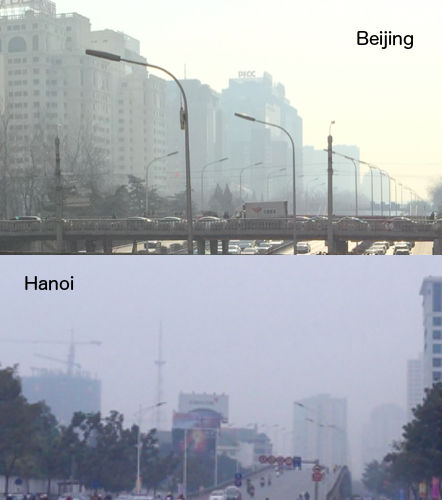Earlier this week (of February 2015), we got several inquries from Hanoi citizen wondering about the Air Quality Index which was displayed on the Hanoi page (city/vietnam/hanoi).
The main reason for the inquiry was that the Air Quality Index displayed on the World Air Quality Index project was around 50 (green AQI) level, while the outdoor visibilty in Hanoi looked like this:

For reference, on the same day in Beijing where the Air Quality Index in Beijing was arround 180 level, the visibility looks like this picture:

One interesting comment on the above picture for Beijing is that the right-part of the picture is having a worst visibility than the left part. This is actually completely normal, pollution is not always uniform, and depending on the wind direction, one part of the city can have relatively good air quality while the other part can be much worse.

When comparing the visibility for Hanoi and Beijing (see pictures on the right for a comparitive zoomed view), there is no doubt that Air Quality for both cities is at similar level, and, for sure, than if the Beijing AQI is about 180, then it is very likely than Hanoi AQI is much higher than 50.
However, please note that, sometimes, the poor visibility is due to high humidity rather than air pollution (smog). The easiest way to differenciate between humidity and smog is by checking the haze color. If it is yellow or grey, then very likely this is due to smog. But if it is a clean white, then most likely what you are seeing is water vapor (i.e. humidity).
In case you still have some doubts, you can also refer to the Air Quality forecast for your region: The forecast always starts with the current day, so you can check from the first frames of the forecast animation the AQI level for your city.
When you notice such issue with reported Air Quality - then, please, drop us an email and we will do the necessary to check, verify the data, and contact the relevant local EPA to get the issue fixed.
The problem with Hanoi actually happened to be an issue with the monitoring station itself emitting too low values. Once the problem was well identified and acknowledged, it took no time for the local Hanoi EPA (Environment Protection Agency) to fix the issue and get the monitoring station working normally again. Many thanks again to the Hanoi EPA for the effort and quick action.
